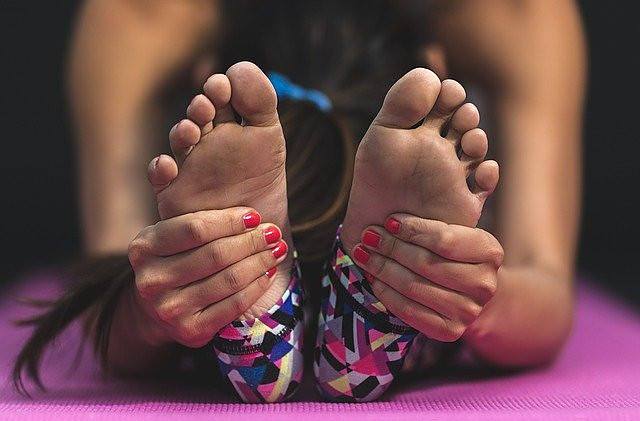Foot tendonitis is the inflammation of any foot tendon. Tendons generally help maintain foot stability and help in your mobility.
One of the most common cause of the foot pain that we experience is foot tendonitis.
The most common types of foot tendonitis are Achilles tendonitis, posterior tibial tendonitis, peroneal tendonitis, flexor tendonitis and exterior tendonitis. The most common of these is Achilles tendonitis.
Nevertheless, exercise is very efficient in relieving most tendon problems. However, you have to be very careful to put correct pressure and stretch on the Achilles tendon when you exercise to relieve Achilles tendonitis.
The primary intention of this guide to help you to identify Achilles tendonitis exercises to avoid.
Before jumping into correct exercises and Achilles Tendonitis exercises to avoid, let’s find out what really Achilles tendon and Achilles tendonitis are.
What is Achilles Tendon?
Amongst the numerous tendons in the body, Achilles tendonitis happens to be the largest. The extent of its stretch is from the bones of the heel to the calf muscles.
It can be felt just at the back of the ankle, as a springy band of tissue.
Without the Achilles tendon, standing on tiptoe won’t be possible. It helps in running, walking and jumping.
This tendon is highly susceptible to lots of injuries, one of which is Achilles tendonitis.
What is Achilles Tendonitis?
 Achilles tendonitis is the inflammation of the Achilles’ tendon as a result of excessive and continuous ‘stress’ activities on the tendon, such as running and jumping. This usually happens when the large Achilles tendon becomes irritated and inflamed.
Achilles tendonitis is the inflammation of the Achilles’ tendon as a result of excessive and continuous ‘stress’ activities on the tendon, such as running and jumping. This usually happens when the large Achilles tendon becomes irritated and inflamed.
Achilles tendonitis is quite a painful experience. However, there are a handful of things we can do to alleviate the pain caused by this tendonitis.
Achilles tendonitis can be in two forms or types
- Insertional Achilles Tendonitis
- Non-insertional Achilles Tendonitis
What is Insertional Achilles Tendonitis?
It is called insertional Achilles tendonitis when the lower portion of the tendon attached to your heel bone is affected.
What is Non-insertional Achilles Tendonitis?
In this case, the middle portion of the tendon fibers is affected. The younger ones are easily affected because of their high level of activities.

What are The Symptoms of Achilles Tendonitis?
Here are the key symptoms of Achilles tendonitis.
- Pain
- The back of your heel gets swollen and causes discomfort
- Tight calf muscles
- The extent of flexing of the foot gets limited
- There is excessive warmness on the skin of your heel
How is Achilles Tendonitis Different from Tendinopathy and Tendinosis?
Often times, we get confused about whether Achilles tendonitis, tendinopathy and tendinosis all mean the same thing. They have almost identical symptoms, so it is normal for people to misinterpret them. But, it should be noted that their differences lie in their conditions.
-
Achilles tendonitis
As noted above, it is just an inflammation to the Achilles tendon, which are often characterized by pain and swelling.
-
Tendinopathy
Tendinopathy is a tendon injury that can occur in any tendon of the body. Most of the tendon injury occurs near joints such as elbow, knee and ankle.

Tendinopathy is used to describe any issue with the tendon. Most times, Tendinopathy fails to heal.
Achilles Tendinopathy is an injury to the Achilles tendon irrespective of the cause.
-
Tendinosis
Tendinosis is the degeneration of a tendon, but it is not ‘inflammatory’ phenomena.
The degeneration can occur due to changes in the composition and structure of the tendon affected. This is the case when a particular tendon is always injured in a close time frame without being allowed adequate time to heal.
Unlike tendonitis, tendinosis may take even months to heal. There may also be a slight difference in treatment options.

Achilles tendinosis is the degeneration of Achilles tendon, which is not due to inflammation.
What Could Cause Achilles Tendonitis? What Are The Contributing Factors?
Achilles tendonitis does not just occur, there are so many things that contribute to its occurrence.
The most common cause of Achilles tendonitis, as noted earlier, is excessive exercise, which involves jumping or running.
Any activity that you engage in often, which causes strain to your Achilles tendon can cause tendonitis.
Some of the causes include the below.
- When you exercise without warming up properly
Warming up before exercise keeps your blood flow and muscles active and reduce the risk of inflammation.
- Repeatedly perform activities that will strain your calf muscles
Excessive strain to your calf muscle could increase your risk of inflammation.
- Engaging in sports that need a quick change of positions and directions
For example, table tennis, tennis and volleyball.
- When you spontaneously increase your time for exercises without allowing your body to adapt for it appropriately.
- Putting on shoes that are undersized or too tight for you.
This is going to limit blood flow to your calf muscles, and this opens the risk of inflammation.
- Stepping on high heel shoes for an extended period of time.
This can put excess stress on the Achilles tendon and increase the risk of inflammation.
- Old age weakens the Achilles tendon.
As you age, the strength of your Achilles tendon diminishes, so you should be more careful at this time.
Asides physical activities, other health issues could also cause Achilles tendonitis. As examples, Rheumatoid Arthritis and infections.
Rheumatoid arthritis, like other forms of arthritis, is an autoimmune disease, but unlike other forms, the pain in the joint reflects throughout the body. Here, the damage to the joint affects both sides of the body.
Treatment of Achilles Tendonitis
There are various ways in which Achilles tendonitis can be treated. It has both home remedies and medicines that can be prescribed by the doctor.

Tip: Wearing a good splint, such as Ossur Exoform will play a major role in your successful speedy recovery.
Home Remedies for Treating Achilles Tendonitis
The home remedy for treating Achilles tendonitis includes the following.
o The first step is to take a rest.
The importance of rest at this point can’t be overemphasized. Taking a rest will help relax you and reduce the risk of further inflammation.
o Reduce the physical exercises you engage in.
o Stretch your calf muscles gently.
o Find a more suitable exercise that is not strenuous.
o Use a cold compress to massage your calf muscles.
o Put your legs up to reduce swelling.
o Use a brace or walking boot to prevent movement of your heels
o Visit a physical therapist.
Tip: Air Cast Ankle Brace is one of the bests!
Tips on Effectively Treating Achilles Tendonitis Using Home Remedies
How To Rest?
Do not do anything that will put pressure on the tendon for a few days, until you are sure you can walk without pain.
Healing is faster when no pressure is placed on the tendon at the initial time. Walking aid may be necessary at this point.
Tip: Effects of your rest can improve if you use a knee pillow, such as ComfiLife or Calming Comfort.
Wrapping With Ice Could Do The Magic
Get a bag of ice and wrap them using a clean cloth. Then place it against your skin and keep it still for close to 20 minutes or less.
After that remove it so that the tendon can get warm for a short while.
You will notice that icing reduces swelling to a great extent.
How To Compress?
Tie something, either a bandage, cloth, or tape (athletic) to reduce swelling. It shouldn’t be too tight so as not to inhibit blood flow.

Tip: Did you know Nanosocks can help you recover from Achilles tendonitis too?
How To Raise Up Your Foot?
Raise your foot above your chest. This enables the blood to return to the heart and keep the swelling down.
When the above list of methods fails, then you should consider visiting a specialist doctor as surgery might be the next option. This depends on how bad the rupture is, though.
Why is Exercise Important in the Recovery of Achilles Tendonitis?
Exercises normally help in the proper functioning of the various systems of the body. When you have Achilles tendonitis, you should consider taking a handful of exercises for the following reasons.
- Some exercises provide relief by loosening the tendon.
- The proper exercise can help in toning the calf.
- Exercises strengthen the muscle already shortened due to inflammation and brings the structure of the tendon to normal.
- Exercises also help to strengthen lost muscle flexibility.
What Exercises Are Good For Your Recovery From Achilles Tendonitis? The Best Exercise
Having established that exercises aid recovery, remember, some exercises can be harmful, while some can be helpful.
There are so many functional exercises that will speed your recovery.
They include:
1. Stretch Exercises
This can be of different forms which include the following forms.
-
Runners stretch exercise
Following the discomfort and tightening caused by inflammation of Achilles tendon, this stretch exercise will help you loosen your tendon.
Here are steps on how to do this exercise
Ø If you are using a wall, your hands should be placed on the wall, at the same level with your eyes. If you are using a chair, stand behind the chair.
Ø Place the leg you want to stretch at your back. Make sure your heel is on the floor, while your toes are raised up.
Ø Place the knee of the unaffected leg in a bent position, and towards the wall, and make sure the back of the leg is straight.
Ø Keep leaning and moving close to the wall, till your calf stretches. This should be done gently.
Ø Repeat three times with each one lasting for 30 seconds.

-
Toe to wall stretch
If the runners stretch places you in an uncomfortable position, especially around the shoulder region, you can try this toe to wall stretch.
This stretch also helps in reducing stress on the Achilles tendon.
Steps to follow while performing the toe to wall stretch
Ø Stand directly in front of the wall, and place your toes at a very high position on the wall. The higher you can place the toes, the deeper you are making your stretch.
Ø Keep leaning close to the wall and keep your other heel on the ground. (The other leg should be behind you)
Ø Repeat 3 times, and each one should last for 30 seconds.
-
Heel drop
This is another stretch exercise for Achilles tendonitis. You can do this using a staircase or step ladder.
In the case of the step ladder, ensure that the ladder is fixed firmly.

Steps on how to perform heel drop
Ø Place your hands on the staircase rail or ladder for stability
Ø Make sure the ball of your foot is on the edge of the last step
Ø Your heel should be down in other for the other foot to be in a relaxed position
Ø Repeat this exercise 3 times. Each one should last for 30 seconds.
Tips for Success in Stretching for Achilles Tendonitis
To be able to get the best result after the stretching exercises, you should keep the following in mind.
- Stretch your achilles tendon regularly even when you stop feeling pain.
- Do not be in a hurry
Your movement should be slow. This is to avoid additional injuries while changing positions.
- Do not bounce
Making spontaneous movement will only cause you further pain. All your movements should be well calculated.
- Once you feel pain, seize stretching immediately.
Asides stretching exercises, strength exercises can be very efficient in relieving you from pain caused by Achilles tendonitis.
2. Strength Exercise
These exercises help you regain your strength after having an inflammation of the Achilles tendon.
Tips for Success in Strength Exercises
This is how to perform strength exercise.
- With your heel outside the edge of the step, stand on your foot. It Is important you hold the railings or wall for support and balance.
- Keep pushing with your toes up, as you count to 10 slowly.
- Then come down until your heel is beneath the step. Once you feel pain while doing this, you must stop.
- This exercise should be repeated, a minimum of 8 and maximum of 12.
It could be in 2 phases. The first phase with a straight knee, and the second phase with a bent knee.

Gastrocnemius Heel Drop
How to perform?
- Stand with the affected foot placed on a step with the heel raised.
- Bring down the heel, with the legs in a straight position, until the foot is parallel to the ground. Don’t go further than this.
- This should be done repeatedly (3*15)
- Do this every day for 12 weeks.
Achilles Tendonitis Exercises To Avoid
There are some exercises you should never try once you have Achilles tendonitis.
We already established that Achilles tendonitis occurs as a result of stress in the Achilles’ tendon. So, any exercise that will cause further stress should be avoided.
The exercises that you should avoid doing include below.
Ø Running
Race of any kind should be avoided, as it might now cause rupture to the already inflamed tendon.
Ø Walking long distances
Some people love to walk early in the morning as a form of ‘mental’ exercises. However, once you have Achilles tendonitis, this should be stopped to avoid chronic inflammation.

Ø Volleyball
This is a sport that has to do with a sudden change of positions, so should be avoided.
Other exercises that have to do with a change of positions like – football, basketball, table tennis, tennis, cricket, etc. also should be avoided.
What Happens If Achilles Tendonitis Goes Untreated Or If The Tendon is Stressed?
Once you have Achilles tendonitis, it limits the activities you can engage in.
So, if you do not treat the infection immediately, that could put a stop to your career if the Achilles tendonitis gets worse.
Not treating it could cause prolonged pain, and the inflammation could become chronic.
A chronic Achilles tendonitis could lead to a further complication known as Achilles tendinitis. This is where the inflammation becomes acute. This, in turn, can cause ‘chronic’ or long-term damage to the tendon.
Tip: Having Plantar Fasciitis? Then, using a Futuro Night Support Split is a popular recommendation.
Conclusion
Achilles tendonitis, as painful as it can be, but it has effective remedies, treatments and exercises, which can cure it.
In order to avoid further complications, treat it immediately, you notice it, by doing a handful of good exercises. Avoiding the above Achilles tendonitis exercises to avoid is paramount in getting things right.
Tip: HealthyLine Heating Mats can help your body to enhance healing from inflammations.









0 Comments